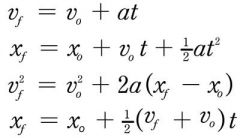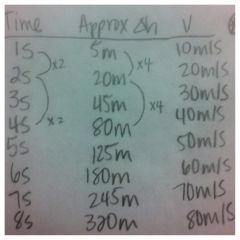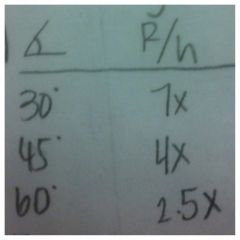![]()
![]()
![]()
Use LEFT and RIGHT arrow keys to navigate between flashcards;
Use UP and DOWN arrow keys to flip the card;
H to show hint;
A reads text to speech;
57 Cards in this Set
- Front
- Back
|
Formula for velocity
|
v= ΔX/t
Velocity=displacement/time |
|
|
Formula for acceleration
|
a=Δv/t
|
|
|
Difference between speed and velocity
|
Speed=x/time
Velocity=ΔX/t |
|
|
SOH CAH TOA
|
sin= opposite/hypoteneuse
Cos=adjacent/hypothesis Tan=opposite/adjacent |
|
|
Cos, Sin for 0°, 30°, 45°, 60°, 90°
|

|
|
|
4 main equations for uniform linear motion (kinematics)
|

|
|
|
For an object in free fall what is the relationship between the time (s) and the velocity (m/s)?
|
As time doubles (X2) the Δh changes by a factor of 4 (X4)
|
|
|
Trick: Give the Δh for time points 1s-8s for an object in free fall.
|

|
|
|
Formula for Force
|
F=ma
|
|
|
Formula for Weight
|
W=mg
|
|
|
Newton's law of Universal Gravitation
|

where G=6.67 X10^-11
|
|
|
Relationship between Range/Height as the angles (30°, 45°, and 60°) change
|

|
|
|
1 radians is approximately how many degrees?
|
1rad=60°
|
|
|
Formula for Centripetal acceleration
|
ac=V2/r
|
|
|
Peak height of a projectile
|
Vosinϴ=√2gh
|
|
|
Normal Force on inclined plane
|
FN=mgcosϴ
|
|
|
Net force due to gravity on inclined plane
|
mg=mgsinϴ
|
|
|
Force of Static Friction
|
Fs ≤ µs*Fn
|
|
|
Force of Kinetic Friction
|
Fk ≤ µk*Fn
|
|
|
Hooke's Law
|
F = -k*Δx
Where k relates to shape |
|
|
5 steps for physics problems!
|
1. Confidence
2. Diagram 3. System 4. Formula 5. Plug and chug |
|
|
Normal Force formula for curved surface
|
Fn = mgcosϴ + mv^2/r (centripetal force)
|
|
|
What happens to the force if you double the distance,
|
Decrease the force by 4 times
|
|
|
The sharper the turn the _______
|
smaller the radius of curvature
|
|
|
Frictionless inclined plane:
Only forces are ____ and the ____ forces. |
gravity
normal |
|
|
Torque Formulas
|
T = Frsinϴ
T = Fl l=leverarm [Position vector is from point of rotation to point where force acts at 90 degress] |
|
|
Kinetic Energy Formula
|
K = (1/2)mv^2
|
|
|
Mechanical Advantage on a Pulley System
|
mechanical advantage= mobject/#ofstrings
|
|
|
Define mechanical advantage
|
W object/ applied force
|
|
|
Mechanical advantage of Inclined plane
|
1/sinϴ
|
|
|
Formula for Work
|
W=mgcosϴ
W=KEf-KEi |
|
|
If work is done on an object the object ________energy.
If work is done by an object the object _____________ energy. |
gains, looses
|
|
|
Potential Energy
|
PE=mgh
|
|
|
Potential energy in a spring
|
Uspring=1/2kΔx2
|
|
|
Formula for Power
|
P=W(joules)/t(sec)
|
|
|
What are the two special right triangles?
|
3-4-5. and 5-12-13.
|
|
|
Air resistance affected by which factors
|
-Shape: smooth=less air resistance
-Velocity: increased velocity=increased air resistance -Mass: None |
|
|
What is one thing that affect flight time of an object ignoring air resistance?
|
Y direction velocity
|
|
|
How do you solve for the following: Mass pulling on a rope and the rope and gravity pulls the mass downward and tension pulls upward, pretend it is in equilibrium
|
Set upward forces to downward forces which gives us tension = mg
We then add MA to the weaker side, so we add it to the tension side: Tension + MA = mg |
|
|
Formula for momentum
|
P = mv
|
|
|
Mechanical Advantage in rotational equlibirium
|
distancefulcrum/distanceweightfromother
|
|
|
Conditions of rotational eqlbm
|
F=0
T=0 Fup=Fdown Fleft=Fright Fclockwise=Fcounterclockwise |
|
|
Conservation of momentum
|
m1v1i+m2v2i=m1v1f+m2v2f
|
|
|
Formula for impulse
|
J=Δmv= mvf-mvi= FΔt
|
|
|
If an object comes to rest quick, Force_____ and impulse ______________
|
increases, decreases
|
|
|
If an object comes to rest slowly, force_____ and impulse________
|
decreases, Increases
|
|
|
Elastic collisions
|
mechanical energy is conserved
sum of mechanical energies before collision equals sum of mechanical energies after collision Uinitial + Kinitial = Ufinal + Kfinal |
|
|
Inelastic collisions
|
colliding objects lose some mechanical energy to internal energy
must use conservation of momentum to solve inelastic collision problems Pinitial = Pfinal completely inelastic collision is when the colliding objects stick together upon collision M1V1 + M2V2 = (M1+M2)V3 |
|
|
An ____ is a helium nucleus - two protons and 2 neutrons
If you have a substance undergoing ____ you subtract 4 from its mass number and 2 from its atomic number. |

alpha particle
alpha particle |
|
|
In ____ an electron is emitted and a neutron becomes a proton.
This means that the atomic number increases and mass number stays the same. |

Beta decay (top)
|
|
|
In ____ emission a ____ is created and emitted from a nucleus.
____ emission, proton becomes a neutron. The mass number stays the same and the atomic number drops by 1. |
Positron
Positron |
|
|
Speed of light
|
c=3.8X10^8 m/s
|
|
|
____ - an electron crashes into a proton to form a neutron.
The mass number stays the same and atomic number drops by 1. |

Beta aka electron capture (bottom)
|
|
|
Radioactive Decay
|
5 types:
1. alpha decay 2. beta decay 3. positron emission (beta decay) 4. gamma ray production 5. electron capture (beta decay) |
|
|
What are the temperatures in Kelvin and Celsius for the following?
1. Absolute zero 2. Freezing point of water 3. Boiling point of water |
1. -273 C. 0 K.
2. 0 C. 273 K. 3. 100 C. 373 K. |
|
|
Formula for time to reach apex
|
Apextime=Viy/g
|
|
|
Kepler's Laws of Orbital Motion
|
1. All orbitals are eliptical
2. When closer to the object (r decreases) it is orbiting- v,a,F,p,KE increases 3. Tsquared is proportional to R cubed. As orbital radius increases so does the period. |

